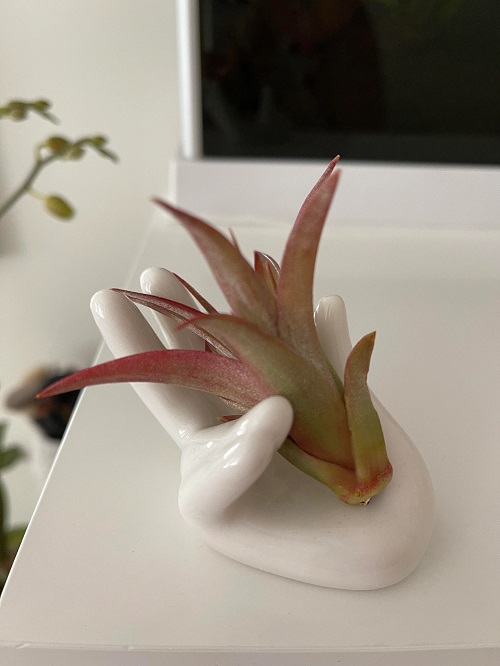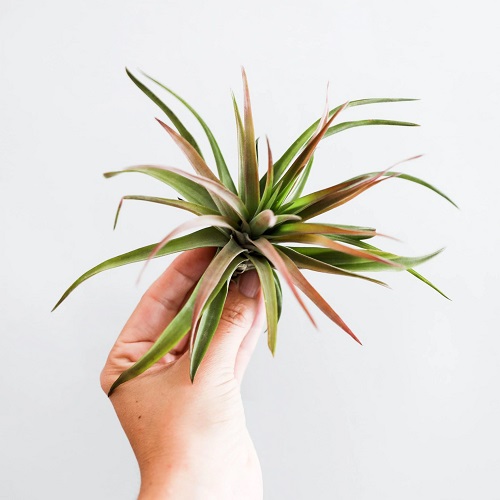Worried Why is My Air Plant Turning Red? Explore the reasons and solutions for this color change in air plants.
Air plants, also known as Tillandsia, are beloved for their unique ability to thrive without soil. While they typically exhibit beautiful shades of green, it can be concerning when they start turning red. In this article, you’ll explore the reasons behind Air Plant Turning Red and get solutions to help your air plant regain its vibrancy.
Air Plant Turning Red- Reasons and Solutions

1. Natural Lifespan:
One of the most common reasons for an air plant turning red is its natural lifecycle. Air plants are monocarpic, which means they produce a single flower and then begin to decline after blooming. As they approach the end of their life cycle, the leaves may turn various shades of red, orange, or purple before eventually withering and dying. This color change is entirely normal and should not be a cause for concern.
Solution: If your air plant is turning red due to its natural lifecycle, there’s not much you can do to reverse it. Instead, focus on providing proper care and consider propagating new air plants from offsets or seeds.
2. Stress:
Just like any other living organism, air plants can experience stress. Factors such as extreme temperature fluctuations, excessive sunlight, or insufficient watering can stress your air plant, causing it to turn red. To prevent this, ensure your air plant is placed in a suitable location with the right amount of light and follow a proper watering routine.
Solution: To alleviate stress-related redness, ensure your air plant is situated in a stable environment. Maintain consistent lighting, temperature, and humidity levels. Establish a regular watering routine, ensuring the plant gets enough moisture without becoming waterlogged.
3. Sun Exposure:
Air plants thrive in bright, indirect light, but too much direct sunlight can lead to redness. If you notice your air plant turning red and it’s been exposed to intense sunlight, consider moving it to a more shaded area to prevent further color change.
Solution: Move your air plant to a location with less direct sunlight if overexposure is causing redness. They thrive in bright, indirect light. A sheer curtain or placement near a window with filtered light can be ideal.
4. Seasonal Changes:
Air plants might change color in response to seasonal variations in temperature and humidity. During colder months or when subjected to drier conditions, they may exhibit reddish hues as a protective response to conserve moisture. Maintaining a consistent environment for your air plant can help minimize these color fluctuations.
Solution: Adjust your care routine to accommodate seasonal variations. During colder or drier months, mist your air plant more frequently or soak it for a longer duration. Monitor the humidity levels in your home and use a humidity tray if necessary.
5. Fertilization:
While air plants don’t require frequent fertilization, using a specialized air plant fertilizer can enhance their overall health and vibrancy. However, over-fertilization can lead to an air plant turning red. Be sure to follow the recommended fertilization schedule for your particular air plant species.
Solution: Stick to a balanced and minimal fertilization schedule, typically once a month. Dilute air plant-specific fertilizer to half strength and avoid applying it during the dormant phase. Flush the plant with water after fertilizing to prevent excess buildup.
6. Genetic Variations:
Some air plant species naturally have red or reddish leaves as part of their genetic makeup. If your air plant has always had red leaves or has a red hue that remains consistent over time, it might simply be a characteristic of that specific species.
Solution: If your air plant naturally has red or reddish leaves due to its genetics, there’s no need for concern. Simply embrace its unique appearance and continue providing proper care.
FAQs
1. Will my red air plant return to its original color?
A: If the redness is due to natural causes like stress or seasonal changes, your air plant may revert to its original color once the stressors are addressed or the season changes. However, if it’s due to genetic traits or nearing the end of its lifecycle, the red color may persist.
2. Can I revive a red air plant?
A: Unfortunately, if your air plant is turning red due to its natural lifecycle, there’s no way to revive it. However, you can propagate new air plants from offsets or seeds to continue enjoying these unique plants.
3. What is the most important thing to remember about red air plants?
A: The most crucial thing to remember is that air plants have diverse reasons for turning red. By identifying the cause and applying the appropriate solutions, you can help your air plant regain its vibrancy and stay healthy for years to come.

